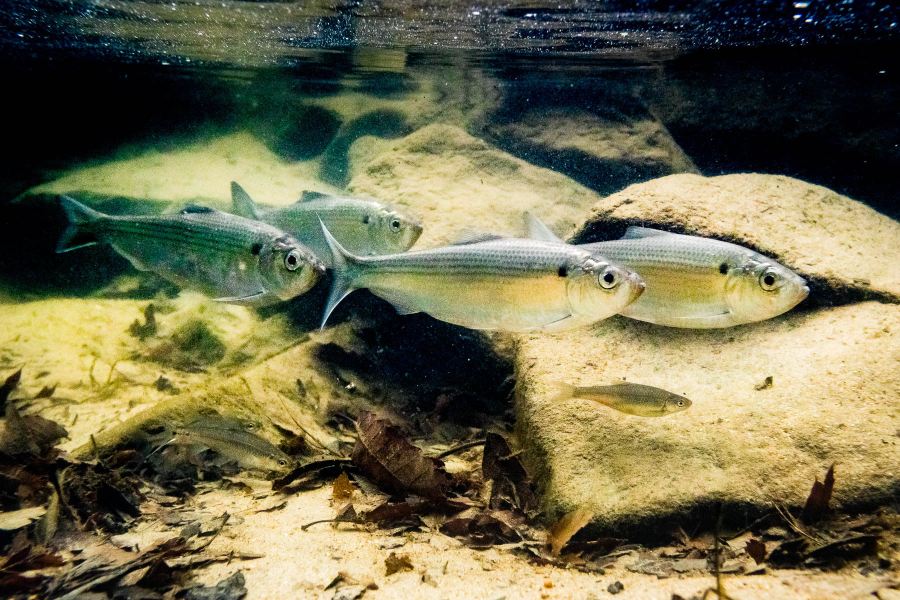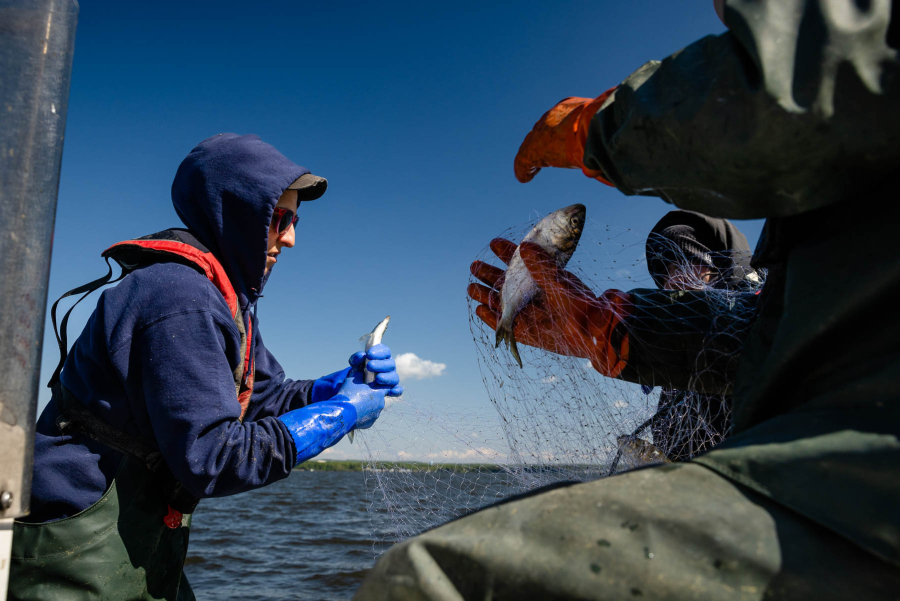Over 31,000 miles of fish passage opened in the Chesapeake since 1988
Shad, herring, striped bass and more benefit from fish passage projects

Each spring, the season’s warm weather kicks off a sequence of spawning runs for migrating fish in the Chesapeake Bay.
First up are the striped bass, though they don’t have too far to go. As a “semi-anadromous” species, the 30–40-pound fish lives mostly in the mainstem of the Chesapeake Bay and migrates just a short way into the estuary's rivers to spawn (lay eggs). The fully anadromous fish—namely shad and herring—travel much farther, swimming thousands of miles from the Atlantic Ocean and up into the Bay’s freshwater rivers to reach their ancestral spawning grounds.
In some parts of the Chesapeake watershed, these spawning runs are alive and well. Anglers head out to their preferred fishing spots to take advantage of this short window, which lasts just a few short weeks for each species, while eagles and herons feast from above.
But overall, the spawning runs are much smaller than they once were, and each fish is on shaky ground, population-wise. While American shad once supported a prosperous commercial fishery (the first-ever in Maryland), it’s now known as the “forgotten fish” due to a severe population decline. Striped bass made a major recovery in the 1990s after Maryland and Virginia paused commercial fishing, but has been declining in numbers again since 2010. The herring fishery has also seen a dramatic decline in the United States, with landings decreasing 90% in recent decades.
Overfishing, polluted waters and a lack of access to food have all played a part in the decline of these species, but one of the biggest factors is barriers to spawning grounds.
For over 30 years, the Chesapeake Bay Program has been working to improve passage for migratory fish, whose migration corridors are blocked by hundreds of dams, bridges and outdated culverts built in the late 19th and early 20th century. By removing these barriers, our Fish Passage Workgroup supports not only striped bass, herring and shad, but also the American eel, that lives in freshwater rivers and spawn in the ocean, and the beloved brook trout, that migrates up and down freshwater tributaries.
The Bay Program has opened over 31,000 miles of stream habitat since 1988, and with each dam breach, culvert upgrade and fish ladder installation, we see fish species showing up in places they haven’t been for decades, if not centuries. In such a challenging time for the Bay’s health, this work gives us hope for the estuary’s wildlife.
Opening over 31,000 miles of fish passage
On a winter morning in 2004, deep-sea divers from the U.S. Army ventured into 32-degree water, hauling 50-pound hydraulic jack hammers to drill holes in the back of Embrey Dam on the Rappahannock River. The team was guided by both the U.S. Army Corps of Engineers and U.S. Air Force Reserves—a special training program called in to help detonate the dam and remove the obstruction from the tributary.
“We’re gonna blow this bad boy up come Monday morning,” said U.S. Army squad leader, Michael Poole, in a 2004 recording of the event.
Embrey Dam had been targeted by members of the Chesapeake Bay Program’s Fish Passage Workgroup as a key barrier to remove as early as 1988. The 22-foot-tall construction had outlived its usefulness for generating power and was no longer needed to supply drinking water in the nearby city of Fredericksburg, Virginia.
With the removal of the dam, migratory species found access to spawning grounds they hadn’t been able to reach for over 150 years.
“The hickory shad just poured through,” recalled Alan Weaver, fish passage coordinator with the Virginia Department of Wildlife Resources (DWR).
DWR is a key member of the Fish Passage Workgroup and has been surveying fish in the Rappahannock since Embrey was removed. According to Weaver, by 2008, American shad were found 28 miles upstream from where Embrey used to stand, at a survey location called Kelly’s Ford. In 2009, blueback herring were found in Kelly’s Ford as well as striped bass. And by 2016, the Smithsonian Environmental Research Center (SERC), another Workgroup member who conducts research on the Bay’s migratory fish, tracked blueback and alewife 62 miles from the ghost of Embrey Dam.
“Bottom line is we know they’re using the habitat,” Weaver said.
The removal of Embrey Dam is one of several success stories for the Fish Passage Workgroup, which brings together state and federal agencies, nonprofits and academic institutions to identify dams that should be removed and determine how to do it.
“The biggest benefit of the Fish Passage Workgroup is that you have a variety of different agencies and organizations that can work together to figure out what priorities there are and then collectively pursue them,” said Jessie Thomas-Blate, dam removal expert with American Rivers.
A similar story can be found along the Patapsco River in Maryland. The removal of Bloede Dam is one of the most well-known in Maryland, but it was actually preceded by two others. The first to go was Union Dam up in the Patapsco headwaters, which was removed in 2010. Next was Simkins Dam, which was downstream of Union and went down in 2011. It took several years for the state of Maryland to take on the biggest and most expensive removal of them all, the Bloede Dam, which was finally removed using a controlled explosion in 2018. Just like in the Rappahannock, migratory fish are now passing more readily through the Patapsco.
“We've seen eight species upstream of Bloede Dam that were not observed pre-removal,” said William Harbold of Maryland Department of Natural Resources. “Alewife, blueback herring, gizzard shad, white perch, striped bass, yellow perch, quillback and northern snakehead.”
Like humans, fish leave behind DNA when they travel, and this can be captured in a water sample to determine where they were. According to SERC, since the removal of the Bloede Dam the likelihood of detecting the environmental DNA (eDNA) of alewife increased from 0% to 5% and from 0% to 13% for blueback herring.
“This research is important because it indicates that the primary objective for Bloede Dam’s removal—to restore migratory fish passage in the Patapsco River—has been met for river herring,” said Henry Legett, a SERC scientist involved in the study.
While the largest dams tend to be owned by the state or big energy companies, a majority of the Bay’s blockages are actually privately owned. This is particularly true in Pennsylvania, where some 70% of the Commonwealth’s dams are owned by private landowners. In these cases, removing the barriers doesn't require army divers or dynamite to remove, just permission.
Within the Fish Passage Workgroup, nonprofit organizations such as Trout Unlimited and American Rivers work with landowners to communicate the benefits of removing their dams. In West Virginia, Pennsylvania and part of Maryland, supporting brook trout populations is an especially compelling reason to improve passage along smaller rivers and streams.
Resident fish such as brook trout, who spend their entire lives in the watershed’s various freshwater streams, can also be blocked from their spawning ground or any general habitat with food and shelter from predators when dams are in place. In upstream locations as distant as the West Branch of the Susquehanna River, which runs to the farthest stretches of the Bay watershed, homeowners have removed dams to improve local fishing and water quality.
Landowners also remove their dams because they can be a hazard to people on the river or because they’re in danger of collapsing.
“A large percentage of the dams across the country are more than 50 years old,” Thomas-Blate said. “They're in various stages of breaking down, especially if they're not actively maintained by whoever owns them.”

While the majority of dams in the watershed aren’t operational, some larger ones are still in use. In these cases, Workgroup members have installed fish passage devices to help species migrate. These devices, sometimes called “fish ladders” or “fish ways” will use the natural flow of a river to help fish ascend a series of steps and exit the dam on the other side.
Since 1999, Bosher’s Dam on the James River has had a fishway that provides migratory species with access to 137 miles of the river and 168 miles in its tributaries. Not since 1823 could migrating fish, such as American shad, swim past the dam. Another example is the Conowingo Dam on the Susquehanna River, which provides 165,000 Maryland homes with clean energy. Because this dam can’t be removed, wildlife managers have installed three fish ladders to help shad and herring migrate, and have also physically trucked the fish upstream.
However, in the past 10 years, the Fish Passage Workgroup has been moving away from fish ladders to focus on dam removals. According to Jim Thompson, fish passage coordinator with Maryland DNR and chair of the workgroup, some of the best fish ladders are only 30% effective. While these devices are necessary for dams we still rely on, they’re not a silver bullet.
On the other hand, fish passage devices have proved more successful when designed for one species in particular—the American eel. At the eel ladder on Daniels Dam in the Patapsco River, for instance, over 36,000 eels maneuvered past the dam in 2022. This is partly due to the effectiveness of the ladder but also because of Bloede being removed downstream.
“We had a huge success with American eel out there,” Thomas-Blate said.
The Conowingo Dam also has an eel lift, which has played a part in the species’ comeback within the Susquehanna River. This snake-like fish might not be the most beautiful looking critter, but it provides a unique benefit to freshwater mussels, who clean the water by filter-feeding. After spawning, mussel larvae migrate upstream by attaching themselves to the gills of “host fish” such as eels.
“That’s the only way those populations will survive,” said Chris Guy, biologist with the U.S. Fish and Wildlife Service.
The future of fish passage
You can be sure that more dam removals are on the horizon for the Fish Passage Workgroup. In the deep headwaters of the Patapsco River, for instance, Daniels Dam stands as the last major dam since Union, Simkins and Bloede all went down. According to Thomas-Blate, the state of Maryland is weighing the cost of removal against the cost of repairs for the dam.
But beyond dam removals or fish ladders, the Workgroup is setting its sights on upgrades to other man-made structures blocking fish passage, such as culverts. When a new road or small development is built that crosses a stream, a culvert has to be put underground to allow the waterway to continue. However, many of the culverts in the watershed are outdated and don’t do a good job of allowing fish to successfully migrate.
According to Thompson, most of the blockages from culverts occur with state and county-owned roads, which makes it easier to get permission and support for removing them. Thompson said that funding from the Bipartisan Infrastructure Law will allow the Fish Passage Workgroup to pursue culvert upgrades across the watershed, supplementing the larger dam removals and fish ladders.
As this work continues, it’s important to remember that migratory fish like striped bass, shad, herring, American eel and brook trout face various threats to their survival, and that removing a dam doesn’t immediately resolve the generations of fish impacted by blockages.
“It’s going to take multiple generations of fish to see a change,” Thompson said.
However, as improvements are made to water quality and habitat is improved in more of the Bay rivers, migratory fish will enjoy the new access to these spaces.

Comments
There are no comments.
Thank you!
Your comment has been received. Before it can be published, the comment will be reviewed by our team to ensure it adheres with our rules of engagement.
Back to recent stories